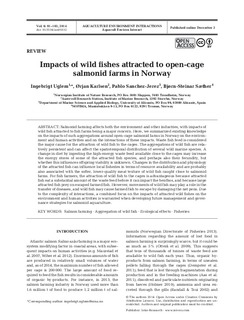| dc.contributor.author | Uglem, Ingebrigt | |
| dc.contributor.author | Karlsen, Ørjan | |
| dc.contributor.author | Sánchez-Jerez, Pablo | |
| dc.contributor.author | Sæther, Bjørn-Steinar | |
| dc.coverage.spatial | Norway Norge | nb_NO |
| dc.date.accessioned | 2015-03-09T11:59:42Z | |
| dc.date.accessioned | 2016-06-23T08:12:50Z | |
| dc.date.available | 2015-03-09T11:59:42Z | |
| dc.date.available | 2016-06-23T08:12:50Z | |
| dc.date.issued | 2014 | |
| dc.identifier.citation | Aquaculture Environment Interactions 2014, 6:91-103 | nb_NO |
| dc.identifier.issn | 1869-7534 | |
| dc.identifier.uri | http://hdl.handle.net/11250/2393747 | |
| dc.description.abstract | Salmonid farming affects both the environment and other industries, with impacts of wild fish attracted to fish farms being a major concern. Here, we summarized existing knowledge on the impacts of such aggregations around open-cage salmonid farms in Norway on the environment and human activities and on the interactions of these impacts. Waste fish feed is considered the major cause for the attraction of wild fish to the cages. The aggregations of wild fish are relatively persistent and can affect the spatiotemporal distribution of several wild marine species. A change in diet by ingesting the high-energy waste feed available close to the cages may increase the energy stores of some of the attracted fish species, and perhaps also their fecundity, but whether this influences offspring viability is unknown. Changes in the distribution and physiology of the attracted fish can influence local fisheries in terms of resource availability and are probably also associated with the softer, lower-quality meat texture of wild fish caught close to salmonid farms. For fish farmers, the attraction of wild fish to the cages is advantageous because attracted fish eat a substantial amount of the waste feed before it can impact the benthos, and because large attracted fish prey on escaped farmed fish. However, movements of wild fish may play a role in the transfer of diseases, and wild fish may cause farmed fish to escape by damaging the net pens. Due to the complexity of interactions, a combined focus on the impacts of attracted wild fishes on the environment and human activities is warranted when developing future management and governance strategies for salmonid aquaculture. | nb_NO |
| dc.language.iso | eng | nb_NO |
| dc.rights | Navngivelse-Ikkekommersiell-DelPåSammeVilkår 3.0 Norge | * |
| dc.rights.uri | http://creativecommons.org/licenses/by-nc-sa/3.0/no/ | * |
| dc.subject | Salmon farming | nb_NO |
| dc.subject | Aggregation of wild fish | nb_NO |
| dc.subject | Ecological effects | nb_NO |
| dc.subject | Fisheries | nb_NO |
| dc.title | Impacts of wild fishes attracted to open-cage salmonid farms in Norway | nb_NO |
| dc.type | Journal article | nb_NO |
| dc.type | Peer reviewed | nb_NO |
| dc.date.updated | 2015-03-09T11:59:42Z | |
| dc.source.pagenumber | 91-103 | nb_NO |
| dc.source.volume | 6 | nb_NO |
| dc.source.journal | Aquaculture Environment Interactions | nb_NO |
| dc.identifier.doi | 10.3354/aei00112 | |
| dc.identifier.cristin | 1184167 | |


